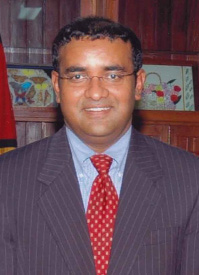President Bharrat Jagdeo said more land may be made available for sugar cane cultivation since his administration is now “seriously” looking at producing ethanol from molasses, in keeping with the Low Carbon Development Strategy (LCDS) which promotes the use of biofuels.

Jagdeo said the government was now considering converting some of its molasses into ethanol, which could then be used to blend with fossil fuel as it attempts to reduce emissions in the transport sector. “We have to make a decision whether we use some of our molasses now to convert to ethanol so we can do a blend with fossil fuel. We are thinking seriously about that…,” he said. The President was at the time delivering the feature address at the ‘Low Carbon Development and Community Planning’ conference, which was held at the International Conference Centre on Tuesday night.
According to Jagdeo, some prefeasibility studies have already been done on the project. He pointed to the possible opening of non-forested lands to facilitate the growing of more cane for the production of ethanol. He said the ethanol produced would be for both the foreign and domestic markets.
Developing a local ethanol plant has long been talked about but there has been little forward movement in this regard. In the much-vaunted GuySuCo turnaround plan, the commissioning of an ethanol plant by 2012 was indentified as one of the necessary projects. The plan recommended that the government assist the corporation with securing an investor for the project.
In March of this year a consortium of US and Brazilian investors held preliminary discussions with the government towards setting up an ethanol plant. Fip Motilall of Synergy Investments was among this team of potential investors, which included representatives of VEi Global Inc and Unisystems Inc.
Further, Jagdeo also spoke about the controversial Amaila Falls Hydroelectric Project (AFHEP) which he said has “a relatively small footprint on our forests”. He noted that construction on the plant will begin before the end of the year and according to him, “once completed in 2 ½ to 3 years time will satisfy all of the electricity needs for Guyana.” He said this would allow for the immediate conversion of all the electricity generating capacity from fossil fuel to renewable energy thereby removing that carbon footprint. “Outside of that, it brings additional benefits; lower cost [for] power, greater balance of payment,” he said.
During his address the President noted that alternative energy sources are already being used in the country as he pointed to a power plant that uses bagasse. “We have a power plant, about 30 MW of power, we generate from burning bagasse,” he said.
Jagdeo said the country had already embraced a low carbon lifestyle, where the per capita emission is 1 or 2 tonnes. He, however, pledged to work towards reducing it even further. Linking this objective to planning, the Head of State said that more trees needed to be planted since this would ultimately have health benefits.
Meanwhile, the President also hinted at the need for other forms of planning and for standardization. He pointed to situations where engineers do construction in areas with huge volumes of water, proceed to fill up these canals without building culverts with the capacity to allow the proper flow of water.
“I keep saying can’t you have a standard? That is, if you have a 20 feet canal, the culvert has to be at a minimum 10 feet wide,” Jagdeo stated. He said that owing to the absence of such a standard, time has to be spent by the authorities in digging up culverts, whenever a problem develops. According to him, it was not just necessary to learn about planning in a low carbon environment but about planning generally.
